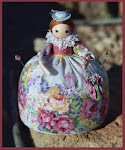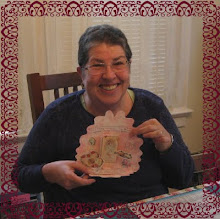Here is my handmade reproduction pop-up Valentine on the little shelf, and underneath is a cool picture frame I found at a large craft store chain. It holds six 4x6" photos and works well for changing out my collection of old postcards and trading cards with the seasons. The cards just slip right in and out.

Instructions for making a repro vintage Valentine. Take an 8 1/2 x 11" piece of scrap paper and fold in half down the middle (top to bottom) and once again along the lower third of the paper. Draw a swirly line on the right, from top to bottom. Cut out through both thicknesses and the left and right sides will match. This is your template.

Crush two pieces of decorative tissue paper (larger than your template) in a ball, then flatten them out again. Do this twice. With a glue stick, adhere the tissue to a piece of cardstock on both the front and the back. Let dry.
Trace around your template onto the tissue-covered card stock and cut out. Using a bone folder press along the line where the vertical and horizontal parts of your card will meet, about 1/3 from the bottom edge. Fold along the pressed line.
If you wish, attach a paper doily frame to the back of the card. I cut a hole from the center of the doily so the pretty tissue paper on the back side would be visible.
To attach the central photo, old postcard or trading card (photocopied, of course), you need to make a support for it. To do this, take a narrow strip of card stock and score along four lines, depending on how tall and how deep you want your support to be. This one, below, is about 4" tall by 1/2" deep (and 1" wide). Therefore, the original piece of cardstock was approx. 1"x 9".

Basically, you are making a box that does not have sides. The back of the box is glued to the vertical part of the card, and the bottom of the box is gluled to the horizontal part of the card. This enables the card to be folded flat, but the artwork will be raised off the card when the card is opened. A little hard to explain, but I hope the photo helps.
Belore I attached the trading card to the support I glued vintage lace around the four edges of the card.

Banners can be made in all shapes and sizes in Microsoft Word:

Glittered sticky letters are applied to the banner. I used a pin to apply them:
>

A second banner, with more sticky letters applied, and photocopied Victorian scrap for the card:

The finished card, with various elements glued to the central pop-up support and elsewhere on the card. I used littly foam sticky dots to give the additional elements dimension.
The underside of the bottom flap contains a poem and more Victorian scrap.

My heart to you is given:
Oh, do give yours to me;
We'll lock them up together,
And throw away the key!
Frederick Saunders)
You can find lots of funny, tender and sweet poems on the internet. Copy and paste them into a Word document in a pretty font. Then tear them and attach to your card.
Come live in my heart and pay no rent. (Samuel Lover)
The back of the card features another poem.

Happy Valentine's Day!
 Jan with her card:
Jan with her card:





































